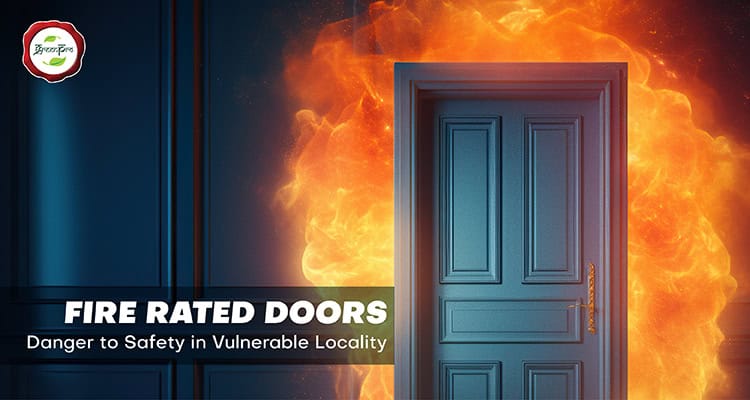As an uncontrolled combustion process, fire poses great danger to human life and property. The dangers of fire are managed through different safety precautions, such as a fire alarm, sprinklers, and the most crucial of all-fire rated doors.
What are Fire-Rated Doors?
Fire doors should not allow the rapid spread of fire over a specific time period. They will be characterized by use of fire resistant materials like steel or concrete. They could also be made from specially treated fireproof wood. They are tested and certified for their ratings with respect to fires resistance.
Fire Resistance Ratings
The classification of fire rated doors depends on its rating on fires which is determined by time and temperature. Standard ratings include:
20 minutes: Resists fire for 20 minutes.
30 minutes: Resists fire for 30 minutes.
60 minutes: Resists fire for 60 minutes.
90 minutes: Resists fire for 90 minutes.
120 minutes: Resists fire for 120 minutes.
The right fire rating for a door will depend on its application and the local building codes.
Fire Rated Door Construction
More generally, the core of most fire-rated doors would be a steel shell filled with compounds made from fire-resisting material, like gypsum, vermiculite, or perlite. Materials, from wood to metal to glass, can provide the covering for the door.
Elements of Fire Rated Doors
Apart from the frame and core, other accessories that fire-rated doors may possess include;
Intumescent seals: These are seals that shall puff out during fire exposure to create a seal about the door so that smoke and flames travel through the door.
Panic hardware: This panic hardware allows people inside to unlock such doors quickly during emergencies.
Holders: These connectors are useful in keeping a door shut, to stop intruders from getting in.
Fire-rated doors in High-risk Areas
Fire-rated doors are a high-risk area fitting required where the risk of fire is much higher. The following is an example of such high-risk areas:
Industrial Buildings: Factories, warehouses and manufacturing plants use flammable materials and can thus be prone to fires. Fire-rated doors can be important in the containment of fire in such buildings.
Commercial Buildings: Offices, supermarkets, and hotels are mainly occupied by human beings. Fire-rated doors would essentially serve as an exit for any individual in a building in the event of a fire breakout.
This includes educational institutions, mainly schools, colleges, and universities. These are the places of knowledge bestowed upon students, but their foremost obligation is the protection of the students’ and staff members’ lives. A fire-rated door would ensure that the fire does not spread and opens the safe evacuation route from the premise.
Healthcare Facilities: There are patients and vulnerable people in hospitals and nursing homes who are expected to be unable to get out quickly in case of fire. They will need fire-resistant doors.
Residential: Fire rated doors are a good safety appliance in single family houses, especially for apartment dwellers.
Uses of Fire-Rated Doors in the Various Places
Fire-rated doors, together with their related hardware, have several uses in various settings, including;
Stairwells: One of the major exit routes in case of fire, and thus, fire rated doors will not allow fire and smoke to spread.
Corridors: Evacuation has been kept in mind while designing the corridors. Fire-rated doors restrict the fire to certain zones and from spreading further.
Exits: Exits become the primary exit points in a building, so fire-rated doors play an important role by allowing people to make a safe exit.
Storage locations: Storage locations include some of the flammable materials, and the fire-rated doors will stop the spreading of the fire if caused.
Fire rated doors can be used to separate different parts of a building, separating offices from storage areas, in order to prevent the spread of fire.
Variations of fire rated doors
There exist many fire-rated doors whose characteristics are defined by differences:
Swinging doors: These are one of the most common types of fire-rated doors and can be single leaf or double leaf.
Sliding doors: Sliding doors are usually used in small space
Rolling steel doors: Rolling steel doors are used more often in industrial applications. They can be manual or motorized.
Fire-resistant glass doors: Fire-resistant glass doors can be used where natural light is desired.
Installation and Maintenance
Proper installation and proper maintenance are essentials that make fire-rated doors effective. They should be installed by qualified persons with adequate skills to ensure that they follow all the relevant building codes and specifications. Periodic inspection and maintenance are done to identify problems causing a drop in the safety of the door and corrected.
Fire-rated doors are integral parts of fire protection in vulnerable areas; they can protect and, maybe, save people’s lives and property through effective prevention of spreading fires and safety exit routes. Fulfillment of statutory requirements in every area and proper installation and maintenance of fire-rated doors is indispensable for this.
